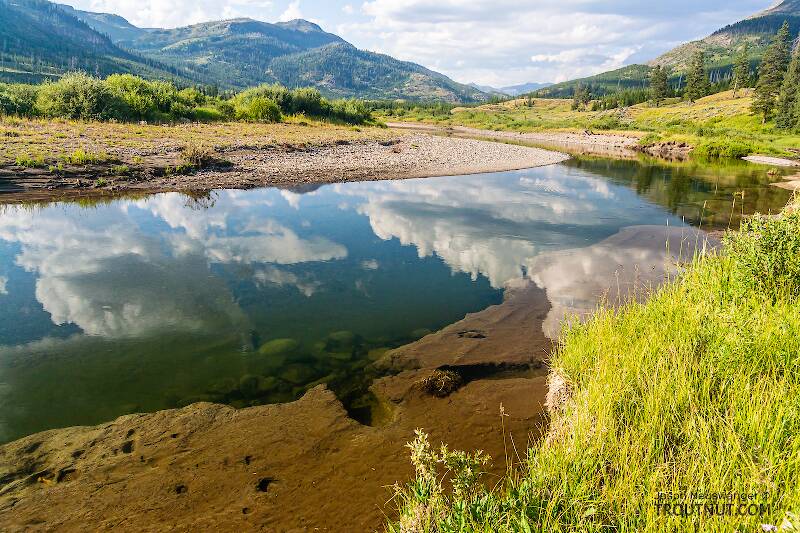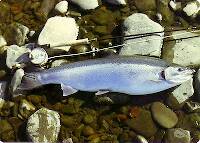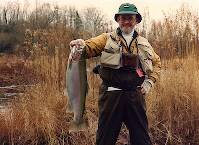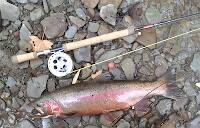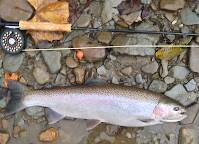
Salmonflies
Pteronarcys californica
The giant Salmonflies of the Western mountains are legendary for their proclivity to elicit consistent dry-fly action and ferocious strikes.
Featured on the forum

This is the first of it's family I've seen, collected from a tiny, fishless stream in the Cascades. The three species of this genus all live in the Northwest and are predators that primarily eat stonefly nymphs Merritt R.W., Cummins, K.W., and Berg, M.B. (2019).

Troutnut is a project started in 2003 by salmonid ecologist Jason "Troutnut" Neuswanger to help anglers and
fly tyers unabashedly embrace the entomological side of the sport. Learn more about Troutnut or
support the project for an enhanced experience here.
Chris_3g
Posts: 59
Posts: 59
Chris_3g on Jan 1, 2007January 1st, 2007, 10:55 am EST
Happy New Year everyone, and I hope everyone had a Merry Christmas as well!
When I started out this fall, I purchased a Cortland outfit off of eBay for $100 - I didn't want to spend a lot of money since I was picking this out as a gift for me from someone else. Anyway, the outfit included an 8.5' 6/7 weight rod and a 6WF line - the rod appears to be medium to fast action and Cortland touts it as a "crisp action rod." After researching more extensively, I realized that I might have been better off with a 5/6 weight and a 5WF (or DT?) line instead.
Anyway, my question is, am I shooting myself in the foot by fishing with this tackle in the streams I'm fishing - smaller streams 15-30 feet wide 2-5 feet deep with rainbows, browns, and brookies. I really don't want to sink another $200 or more into a new rod after only having my current rig for a few months. However, if the tackle is too big for the water I'm fishing, I don't want to waste my time scaring fish all day long either.
Can I use a 5WF (or DT?) line on a 6/7 weight rod without too much trouble - I believe this is termed underlining? I'm not currently at a skill level where I would notice the advantages of the numerous rod technologies, but I assume the fish will notice a heavier line hitting the water. I just wanted to hear everyone's opinion on the matter and also see if there are some specific brands I might look at if my current tackle isn't suitable. Also, if I'm getting a new rod, should I go with a new reel as well? Thanks a lot.
Chris.
When I started out this fall, I purchased a Cortland outfit off of eBay for $100 - I didn't want to spend a lot of money since I was picking this out as a gift for me from someone else. Anyway, the outfit included an 8.5' 6/7 weight rod and a 6WF line - the rod appears to be medium to fast action and Cortland touts it as a "crisp action rod." After researching more extensively, I realized that I might have been better off with a 5/6 weight and a 5WF (or DT?) line instead.
Anyway, my question is, am I shooting myself in the foot by fishing with this tackle in the streams I'm fishing - smaller streams 15-30 feet wide 2-5 feet deep with rainbows, browns, and brookies. I really don't want to sink another $200 or more into a new rod after only having my current rig for a few months. However, if the tackle is too big for the water I'm fishing, I don't want to waste my time scaring fish all day long either.
Can I use a 5WF (or DT?) line on a 6/7 weight rod without too much trouble - I believe this is termed underlining? I'm not currently at a skill level where I would notice the advantages of the numerous rod technologies, but I assume the fish will notice a heavier line hitting the water. I just wanted to hear everyone's opinion on the matter and also see if there are some specific brands I might look at if my current tackle isn't suitable. Also, if I'm getting a new rod, should I go with a new reel as well? Thanks a lot.
Chris.
JAD on Jan 1, 2007January 1st, 2007, 1:23 pm EST
Hi Chris
You might have opened a can of worms---Opps. Theirs many types of fisherman and styles and many roads to travel. I think what you have selected, will work till your skill level increases .One of the best fisherman I know, and fish with uses a noodle rod with the but end hacked sawed off, with an old automatic South Bend reel. He uses the $19.95 cheap Cortland Fair Play Line, the man is a master at catching fish. I personally like long 9 foot 3 wt rods but that's me Gonzo likes shorter rods(I think) and Jason likes something different. I don't think theirs a right answer.
Hope this helps.
JaD
You might have opened a can of worms---Opps. Theirs many types of fisherman and styles and many roads to travel. I think what you have selected, will work till your skill level increases .One of the best fisherman I know, and fish with uses a noodle rod with the but end hacked sawed off, with an old automatic South Bend reel. He uses the $19.95 cheap Cortland Fair Play Line, the man is a master at catching fish. I personally like long 9 foot 3 wt rods but that's me Gonzo likes shorter rods(I think) and Jason likes something different. I don't think theirs a right answer.
Hope this helps.
JaD
They fasten red (crimson red) wool around a hook, and fix onto the wool two feathers which grow under a cock’s wattles, and which in colour are like wax.
Radcliffe's Fishing from the Earliest Times,
Upnorth2 on Jan 1, 2007January 1st, 2007, 10:35 pm EST
I have a Penn 4-weight I like for streams like that. Different for everyone. Penn has a new line of rods out finally. They look great.
Each to his own. 6/7 would have been too much for me.
Each to his own. 6/7 would have been too much for me.
Martinlf on Jan 2, 2007January 2nd, 2007, 2:27 am EST
JaD is right, different folks have their preferences, and no one but you will be able to settle this issue once and for all. That said, I'll venture a few observations. First off, on underlining--when I first started fishing, I was reluctant to use a line that didn't exactly fit the weight printed on the rod. A few trips where I had the wrong spool for a rod and had to make do quickly taught me that if you can make it work, it can work. So here is my recommendation. If you want to fish with a 5 wt. line, buy an inexpensive 5 wt. line and try casting it on your rod. See how it feels to you, and see if you can get the kind of loops and casts that you need to make. If you can make it work, it will work just fine. Or, fish the 6 weight. Some very good fishermen prefer rods much like yours for all around fishing. They make the rods work by casting lightly when they need to, and avoiding line slap. If the fish are stocked, using a 6 weight probably won't make that much difference in many cases, if your casting and leader are right. For wild fish, or for low water conditions, you may benefit from a lighter weight rod. If this is the case, I would recommend a medium fast 3 weight, which can be fished with a 3 wt. line or overlined with a 4 wt. to slow the rod down a bit. Or a 4 wt. I believe Temple Fork rods are hard to beat for the money, but that's just one opinion. As for reels, here's my poor man's solution. After reading a bunch of reviews, I bought an Okuma Sierra 4/5 and three extra spools for it. Using gel-spun backing (bright yellow Powerpro line) and cutting the butt ends of the fly line down a bit to shorten my 5 and 6 wt. lines (to accommodate 150+ yards of backing), I was able to set up a 3 wt. spool, a 4 wt. spool, a 5 wt. spool, and a 6 wt. spool to cover a range of situations. I use the same reel on my 3 wt. 7.5 foot Temple Fork rod for small stream fishing that I use for my 5/6 wt. 9 foot BT rod on big rivers, changing the spools to fit my needs. I've landed 20 inch rainbows on the Henry's Fork using that reel, and 4 inch brookies in tiny mountain trickles. If I ever have the money, I'll invest in another reel or two, but until then I prefer to have multiple rods and one trout reel. If you can make the reel you have work for now, getting a couple of spools may help keep your costs down for a while and allow you to experiment with different rods. Until you get into big fish and open water, the reel doesn't usually make or break your effectiveness in playing a fish. For now you may be able to simply set your drag light, and practice palming the rim, if it is exposed for palming, to add drag when you need it. Most of all, keep experimenting and practicing, knowing that many answers will come with time and experience. Now let's hear what others think!
"He spread them a yard and a half. 'And every one that got away is this big.'"
--Fred Chappell
--Fred Chappell
Shawnny3 on Jan 2, 2007January 2nd, 2007, 10:49 am EST
Hey, Chris. What you have may not be ideal for those streams, but I prefer to see people with equipment below their skill level than above it. You don't want to become what I like to call an "owner". An analogy from golf: If you're shanking your garage-sale clubs 50 yards into the woods on every swing, the only thing that shiny new $500 driver is going to do is allow you to shank 100 yards into the woods. And who wants to be the guy shanking the $500 driver? Same applies to fishing - don't waste the money until you can tell the difference.
I know Lefty Kreh strongly recommends underlining when fishing spooky fish, and I've heard that he's an OK caster. I personally have not tried it, but the next line I buy will be one grade lighter than my rod, just to try it. I'm pretty frugal with my gear.
The heavier rod you now have will allow you to cast farther than you could with a 5-wt, which could be a big advantage if casting distance is a problem for you. Remember, however, the golf example - farther is not always better. In fact, probably the single biggest mistake beginners make is trying to cast farther than their ability allows them to do accurately and in control. If the farthest you can accurately cast and control your line is 10 feet, then never make a cast longer than 10 feet unless you're just practicing. Instead, learn how to approach fish stealthily (a great skill to have anyway) and make solid, controlled casts. I routinely catch savvy fish at distances of 10 feet on dry flies - I say this not to brag but to make it clear that fish often find long casts far overrated. I cannot state this too emphatically: LEARN LINE CONTROL FIRST. If you do, you WILL catch fish, and everything else will follow.
If you're finding navigating small streams with a long rod cumbersome, choke up on the rod handle - you'll be amazed at how much tighter your line control is just by changing your fulcrum position by six inches.
Also, in Ithaca, a 7-wt is a great rod for lake fishing. This spring, take some maribou streamers down to the lighthouse wall and try your luck on some landlocks - if the time is right, that's some pretty cool fishing. Most guys willing to hike the mile out there are pretty serious fishermen, so there are usually some excellent flyfishermen out there who are also really nice guys to talk to and learn from.
-Shawn
I know Lefty Kreh strongly recommends underlining when fishing spooky fish, and I've heard that he's an OK caster. I personally have not tried it, but the next line I buy will be one grade lighter than my rod, just to try it. I'm pretty frugal with my gear.
The heavier rod you now have will allow you to cast farther than you could with a 5-wt, which could be a big advantage if casting distance is a problem for you. Remember, however, the golf example - farther is not always better. In fact, probably the single biggest mistake beginners make is trying to cast farther than their ability allows them to do accurately and in control. If the farthest you can accurately cast and control your line is 10 feet, then never make a cast longer than 10 feet unless you're just practicing. Instead, learn how to approach fish stealthily (a great skill to have anyway) and make solid, controlled casts. I routinely catch savvy fish at distances of 10 feet on dry flies - I say this not to brag but to make it clear that fish often find long casts far overrated. I cannot state this too emphatically: LEARN LINE CONTROL FIRST. If you do, you WILL catch fish, and everything else will follow.
If you're finding navigating small streams with a long rod cumbersome, choke up on the rod handle - you'll be amazed at how much tighter your line control is just by changing your fulcrum position by six inches.
Also, in Ithaca, a 7-wt is a great rod for lake fishing. This spring, take some maribou streamers down to the lighthouse wall and try your luck on some landlocks - if the time is right, that's some pretty cool fishing. Most guys willing to hike the mile out there are pretty serious fishermen, so there are usually some excellent flyfishermen out there who are also really nice guys to talk to and learn from.
-Shawn
Jewelry-Quality Artistic Salmon Flies, by Shawn Davis
www.davisflydesigns.com
www.davisflydesigns.com
CaseyP on Jan 2, 2007January 2nd, 2007, 12:03 pm EST
Chris, everyone has their own approach to your problem because we've all been there and all solved it somehow. in our case, our 9 foot 6 weights (freebies from the class we took) were ludicrously oversized for the tiny rivulet we actually learned on. so off to the sporting goods store where we found 6'6" Eagle Claw fly rods for $20 a pop. spouse just used the 6 wt reel. i bought a cheapish 4 wt reel and used lighter line. we both began to catch fish. the cheap rods were awful, but they taught us about what we wanted: short and fastish action.
when Significant Events Requiring Presents arrived, we were ready to move up the price ladder knowing much more about how we liked to fish and what would help us do it. we discovered that the long 6 weights are great for "rivers", "ponds" and "lakes", and the short lighter weights are good for anything with "creek", "run", or "brook" in the name.
have a good time!
Casey P
when Significant Events Requiring Presents arrived, we were ready to move up the price ladder knowing much more about how we liked to fish and what would help us do it. we discovered that the long 6 weights are great for "rivers", "ponds" and "lakes", and the short lighter weights are good for anything with "creek", "run", or "brook" in the name.
have a good time!
Casey P
"You can observe a lot by watching." Yogi Berra
Martinlf on Jan 3, 2007January 3rd, 2007, 3:53 am EST
Chris, Shawn's advice on practicing casting and targeting fish at close distances is good. Presentation is the key, and it can be done well with all kinds of rods. If your streams are 15 to 30 feet wide, the 8.5 foot rod should be fine, unless there is considerable brush or overhead cover. If the stream is reasonable open, you can fish with what you have for now, possibly choking up a bit if it helps. That said, Casey's solution of finding an inexpensive shorter rod to play with might be one to consider.
"He spread them a yard and a half. 'And every one that got away is this big.'"
--Fred Chappell
--Fred Chappell
Pbaerman on May 4, 2007May 4th, 2007, 6:38 am EDT
I recently purchased a 9' 5wt Temple Fork with matchign 5WF and I absolutely love it. It is a great all around set up that lets me fish small to big (not that big) water and has preformed well when an unexpected 6lb steelhead found my fly.
I completely agree with Martinlf on the Temple Forks being a GREAT(my word)rod for their value. Unless its really big water or really small clear water I use it everywhere.
I completely agree with Martinlf on the Temple Forks being a GREAT(my word)rod for their value. Unless its really big water or really small clear water I use it everywhere.
Many men go fishing all of their lives without knowing that it is not fish they are after. ~Henry David Thoreau
TheMidge on May 6, 2007May 6th, 2007, 2:06 am EDT
I have a 3wt TFO rod like Martin, and really prefer it in small streams. I have only been fly fishing for a couple of years, so I remember when I was starting out I had similar questions. Until you are a pretty good caster, underlining may make it difficult to control your line, something that can be frustrating as you are learning. If you can swing it, I would recommend picking up a smaller rod for waters like you are talking about. TFO is great for the money, as is Cabelas. My favorite rod is an Elkhorn, but you more or less have to order these online from the company, unless you see them at a show, so you don't get the benefit of trying them out. By doing this, combined with the rig that you already have, you will be geared up to fish pretty much any type of trout water you may encounter, from big western waters to the tiny Brookie streams we encounter so often in the northeast. Just some advice that I have recently learned in the last year. If you are watching the budget, I suggest being cheap with the reel, but go for a quality line. I recieved some of the new Cortland 555 line as a gift, and the difference between that and the low-cost fairplay line that I had been fishing is phenominal. Just my 2 cents
Tahdi on May 15, 2008May 15th, 2008, 12:55 pm EDT
Sorry to intrude, Could someone please tell me what what model TFO & Cabela's outfits they are talking about? I want to purchase one for myself and my fishing partner. Cost is an issue though. I'm looking for 4 or 5 weight outfits. We are both new to fly fishing. We have been using ultralight gear since we were kids though. Most of our fishing is in streams/rivers up to 40 feet across. I saw some outfits at Cabela's with IM6 blanks. I think that would be good. I don't want anything that I'll be tired with. We will probably do mostly roll casts. Any help would be greatly appreciated. Thanks
LittleJ on May 15, 2008May 15th, 2008, 1:26 pm EDT
tfo makes the professional series, I think they are in the $150 range and imo the best budget rod on the market.
jeff
jeff
Martinlf on May 15, 2008May 15th, 2008, 2:08 pm EDT
Cabelas makes fine rods so far as I know. My brother-in-law fishes them all the time. I really like my TFO 7.5 3 weight, but my 8' 4 weight TFO may be a bit too stiff for landing fish when nymphing close in. They seem to "bounce" off more easily. Loren Williams, who has fished on the US team, has advised me to go with softer or longer rods for this kind of fishing, and his advice has seemed to pay off. Instead of the 8' 4 weight TFO, recently I've been using an old St. Croix IM6 7'9" rod I built 20 years ago when I want something a bit bigger (but when a 9' rod is too big) and it seems to keep fish from bouncing off at close range, a problem I had seemed to have with the 8' 4 weight TFO rod. He has recommended an inexpensive medium action Cortland rod for close in nymphing, and I will purchase when I have the money. The 7.5 3 weight TFO seems soft enough. I haven't had bounce problems with it.
"He spread them a yard and a half. 'And every one that got away is this big.'"
--Fred Chappell
--Fred Chappell
Tahdi on May 16, 2008May 16th, 2008, 11:06 am EDT
thanks LittleJ. Hey MartinIF, what models were you talking about from Cabela's? thanks
Martinlf on May 16, 2008May 16th, 2008, 3:47 pm EDT
Thadi,
I'd have to ask my brother-in-law to be srue, but I think he uses the medium fast rods.
I'd have to ask my brother-in-law to be srue, but I think he uses the medium fast rods.
"He spread them a yard and a half. 'And every one that got away is this big.'"
--Fred Chappell
--Fred Chappell
Mpemburn on May 27, 2008May 27th, 2008, 1:06 pm EDT
Hi All,
I consider myself to be if not a "beginner" then a "re-ginner", there having been a lapse of a couple of decades between the last time I fished and the present. Back then, I used an 8 1/2' 6wt Orvis 3 pc. that I built from a kit to fish the Housatonic, a good wide river in Connecticut. The waters in my present day neighborhood (Harford Co., MD) are a bit smaller so after a bit of pondering, I put together a new 5wt outfit that I couldn't be more pleased with: 8 ft. Eagle Claw Granger rod, Okuma Sierra 4/5 reel and AquaNova WF5F line. The combination balances well and gives me good control over the relatively short casts that my home waters require. Since my fishing budget is smaller than it was in my carefree youth, I was pleased to pay less than $100 for the outfit (including backing) from Troutlet and Global Dorber. After a suitable pause, I'm inclined to get another in 3wt for the small stream that flows behind my house.
-- Mark
I consider myself to be if not a "beginner" then a "re-ginner", there having been a lapse of a couple of decades between the last time I fished and the present. Back then, I used an 8 1/2' 6wt Orvis 3 pc. that I built from a kit to fish the Housatonic, a good wide river in Connecticut. The waters in my present day neighborhood (Harford Co., MD) are a bit smaller so after a bit of pondering, I put together a new 5wt outfit that I couldn't be more pleased with: 8 ft. Eagle Claw Granger rod, Okuma Sierra 4/5 reel and AquaNova WF5F line. The combination balances well and gives me good control over the relatively short casts that my home waters require. Since my fishing budget is smaller than it was in my carefree youth, I was pleased to pay less than $100 for the outfit (including backing) from Troutlet and Global Dorber. After a suitable pause, I'm inclined to get another in 3wt for the small stream that flows behind my house.
-- Mark
BGrnFlyfish on May 28, 2008May 28th, 2008, 5:16 am EDT
I have a Traditional Series fly rod form Cabelas- 8'6 4wt. combo witha prestige reel which I find perfect for nymphing and dries on the driftless area.
Seth-Big Green River, WI
Martinlf on May 30, 2008May 30th, 2008, 4:27 pm EDT
Mark,
After reading countless reviews I chose an Okuma Sierra reel years ago and am still fishing it. It's never given me a moment of trouble.
After reading countless reviews I chose an Okuma Sierra reel years ago and am still fishing it. It's never given me a moment of trouble.
"He spread them a yard and a half. 'And every one that got away is this big.'"
--Fred Chappell
--Fred Chappell
Fishhook on Jul 24, 2008July 24th, 2008, 12:43 am EDT
My Rod of Choice
I am new to the forum and a returning fly fisherman. I use a Mystic 3 and 5 wt rods and have a number of reels to include an Okuma SLV 23 w/spare spool for floating sinking line for the 3 weight set up and a Scientific Anglers 5/6 weight reel with WF5F line for my 5wt rod. Mysticsoutdoors is a new company and I love their rods. I have some other reels that I have to spool. The streams we fish range from brooks to small rivers so I have the rods to cover down on the action. We also have two very unique species of trout over her called the Manchurian Brown, and Cherry trout. I will post pictures over the next few days.
Regarding tying your own tippets and leaders, what is the best line to use to include diameter for a 3 and 5 wt lines for both dry and wet flies? I realize this is new for both of us so I am hopeful others can comment.
V/R
I am new to the forum and a returning fly fisherman. I use a Mystic 3 and 5 wt rods and have a number of reels to include an Okuma SLV 23 w/spare spool for floating sinking line for the 3 weight set up and a Scientific Anglers 5/6 weight reel with WF5F line for my 5wt rod. Mysticsoutdoors is a new company and I love their rods. I have some other reels that I have to spool. The streams we fish range from brooks to small rivers so I have the rods to cover down on the action. We also have two very unique species of trout over her called the Manchurian Brown, and Cherry trout. I will post pictures over the next few days.
Regarding tying your own tippets and leaders, what is the best line to use to include diameter for a 3 and 5 wt lines for both dry and wet flies? I realize this is new for both of us so I am hopeful others can comment.
V/R
Bob Soska
Best friend's Site:
Mystic Fly Rods - Premium rods without the premium price tag!
www.mysticoutdoors.com
Best friend's Site:
Mystic Fly Rods - Premium rods without the premium price tag!
www.mysticoutdoors.com
Martinlf on Jul 24, 2008July 24th, 2008, 10:24 am EDT
I'm looking forward to pictures. As far as leaders go, I've been told that the butt should flex smoothly with the fly line when attached. I like .018 to .020 leader butts generally when tying leaders for 3 to 5 weight lines, and am partial to George Harvey's formulae. They should be available online somewhere.
"He spread them a yard and a half. 'And every one that got away is this big.'"
--Fred Chappell
--Fred Chappell
Fishhook on Jul 24, 2008July 24th, 2008, 11:11 am EDT
HI Martinlf,
I sinerely appreciate the the sharing of information. I have seen some of the formulas and know there are some difference between the two styles. I remember just using a working leader of about 3 or 4lb. test for the wet flies we used up on the Home Sted near Tobyhanna, PA and on the stream that ran in front of my Grandmothers house in my home town.
Silly question? How do you post pictures here and what is the size limit? I tried to do that last night but gave up?
V/R
I sinerely appreciate the the sharing of information. I have seen some of the formulas and know there are some difference between the two styles. I remember just using a working leader of about 3 or 4lb. test for the wet flies we used up on the Home Sted near Tobyhanna, PA and on the stream that ran in front of my Grandmothers house in my home town.
Silly question? How do you post pictures here and what is the size limit? I tried to do that last night but gave up?
V/R
Bob Soska
Best friend's Site:
Mystic Fly Rods - Premium rods without the premium price tag!
www.mysticoutdoors.com
Best friend's Site:
Mystic Fly Rods - Premium rods without the premium price tag!
www.mysticoutdoors.com
Quick Reply
Related Discussions
Topic
Replies
Last Reply
14
Apr 18, 2011
by Troutnut
by Troutnut
1
Jun 26, 2019
by RleeP
by RleeP
2
Oct 19, 2015
by Wbranch
by Wbranch

